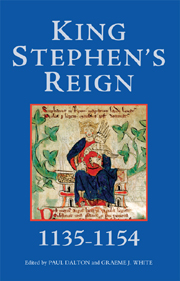Book contents
- Frontmatter
- Contents
- List of Maps
- Preface
- Abbreviations
- Genealogical Table
- Introduction
- 1 Henry I and the Origins of the Civil War
- 2 Royal Income and Regional Trends
- 3 King Stephen and Northern France
- 4 A Week in Politics: Oxford, late July 1141
- 5 Allegiance and Intelligence in King Stephen's Reign
- 6 English Monasteries and the Continent in the Reign of King Stephen
- 7 Reeds Shaken by the Wind? Bishops in Local and Regional Politics in King Stephen's Reign
- 8 Violent Disorder in King Stephen's England: A Maximum Argument
- 9 The Lure of Stephen's England: Tenserie, Flemings and a Crisis of Circumstance
- 10 Legal Treatises as Perceptions of Law in Stephen's Reign
- Index
2 - Royal Income and Regional Trends
Published online by Cambridge University Press: 12 September 2012
- Frontmatter
- Contents
- List of Maps
- Preface
- Abbreviations
- Genealogical Table
- Introduction
- 1 Henry I and the Origins of the Civil War
- 2 Royal Income and Regional Trends
- 3 King Stephen and Northern France
- 4 A Week in Politics: Oxford, late July 1141
- 5 Allegiance and Intelligence in King Stephen's Reign
- 6 English Monasteries and the Continent in the Reign of King Stephen
- 7 Reeds Shaken by the Wind? Bishops in Local and Regional Politics in King Stephen's Reign
- 8 Violent Disorder in King Stephen's England: A Maximum Argument
- 9 The Lure of Stephen's England: Tenserie, Flemings and a Crisis of Circumstance
- 10 Legal Treatises as Perceptions of Law in Stephen's Reign
- Index
Summary
ANY CONSIDERATION of royal income in twelfth-century England is bound to rely very heavily on the pipe rolls. The fact that none survive from Stephen's reign, though an obvious impediment, has not deterred scholars such as Judith Green and Kenji Yoshitake from making important contributions to our knowledge of the king's finances but this paper takes a different approach from that which they adopted. The task in hand here is to compare figures from Henry I's extant pipe roll, that of 1130, with those of the first full roll of Henry II (1156) and to extend the analysis to selected pipe rolls from the rest of Henry II's reign. As a result, some conclusions can be offered about the state of the country and the fortunes of different regions in the period when Stephen was king.
The limitations of the pipe rolls as evidence scarcely need rehearsing here. As Richardson and Sayles put it, they ‘are not concerned with the whole of the revenue and they record the expenditure of but a fraction of the king's resources’. With occasional damage, several entries open to conflicting interpretation, and the risk of human error in transcription and addition (whether in the twelfth century or the twenty-first), it is pointless to press too hard for precision. But Judith Green's masterly study of the 1130 pipe roll showed what could be done, provided that one accepted these limitations and celebrated the lessons to be learned rather than worrying about the pipe rolls' reliability down to the last penny.
- Type
- Chapter
- Information
- King Stephen's Reign (1135–1154) , pp. 27 - 43Publisher: Boydell & BrewerPrint publication year: 2008



